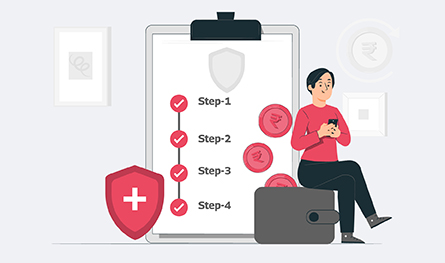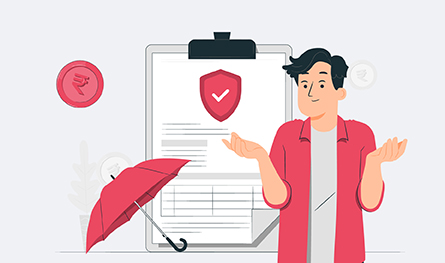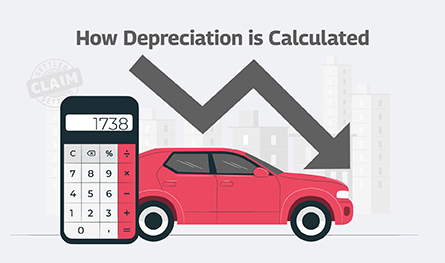Related Articles
 Jan 08, 2025
Jan 08, 2025
Is Varicose Vein surgery covered under the health insurance policy in India
 Health Insurance
Health Insurance

A health insurance reimbursement claim is made when the insured visits a non-network hospital for treatment. Most health insurance policies offer a wide network of hospitals where the insured can avail of a cashless claim. However, knowing the process of raising a reimbursement claim is important for every policyholder. Let's take a look at the step-by-step process to fill out the reimbursement form to raise a health insurance claim.

The best part about getting health insurance for you and your loved ones is that you never have to worry about bearing the financial burden of healthcare costs in case of emergencies. And to make the process even more smooth for you is the exclusive advantage of cashless hospitalization provided by most insurers. This facility can be availed at any of the network hospitals near you, which is provided by your insurance company.
However, it cannot be ignored that medical emergencies can come in uncalled for anytime, anywhere. What if you don’t have access to one of your insurer’s network hospitals at that time? Treatment cannot wait and so you’d need to avail whatever best you have at your disposal at the time. Your insurance company would, however, reimburse the costs borne by you at a non-network hospital up to the limit covered by your insurance plan.
For this, your insurer would ask you to simply fill out a health insurance reimbursement form, a simple document with all the details of your treatment and the costs borne therewith. Read on to know more about this form and how exactly to fill it out in case you ever have to.
As stated above, your insurance company may require you to fill out a reimbursement form in case you did not avail of cashless hospitalization at one of the network hospitals of the insurer. This form is generally handed over to the patient after they have been discharged from the hospital. The patient must submit this claim reimbursement form, along with the other relevant documents, to their insurance company within 15 days of being recharged, after which the company may not entertain your reimbursement claim request.
Here’s how you can complete your claim reimbursement form easily and without making any mistakes:
You would need to submit the relevant details such as the policy number, your name and contact details.
This would include filling out the insurance company’s name under which the patient is covered, the policy number of that health insurance plan, and the total sum insured under that plan. Besides, you may also need to furnish details about prior hospitalization history, if any, and any prior record of insurance coverage for the hospitalization.
You would need to fill out the name of the insured, their relationship with the primary insured person under the policy, their contact details, and their occupation.
You’d be required to collect all original reports for the treatment from the hospital, right from the date of admission until the date of filing the claim. You’d also need all original receipts of hospital bills for all tests conducted as well as pharmacy bills. In case you have any receipts of lump sum cash benefit received from the insurer, attach those as well along with the other documents.
The claim amount would need to be computed based on the pre-hospitalization costs incurred, the expenses borne during the hospitalization of the insured patient, the post-hospitalization costs incurred for the patient, as well as any other costs involving use of ambulance or any health check-ups performed (if applicable).
The insurer would require you to provide your bank name and branch, bank account number, IFSC code, PAN details, and Cheque/DD details.
Make sure to look through the entire form again once you have completed filling it. At the end, the insured would need to provide their signature and mention the date of filing the claim. Also ensure that Part-B of the form (as described in the above section) has been duly filled in by the hospital.
Young and healthy? Find out which of these plans rewards you with lower premiums. Click here to check now!

Paybima Team
Paybima is an Indian insurance aggregator on a mission to make insurance simple for people. Paybima is the Digital arm of the already established and trusted Mahindra Insurance Brokers Ltd., a reputed name in the insurance broking industry with 21 years of experience. Paybima promises you the easy-to-access online platform to buy insurance policies, and also extend their unrelented assistance with all your policy related queries and services.

.jpg)
Having a bike is not just about convenience, it’s a huge responsibility. Financial protection of your two-wheeler is important and the best way to ensure that is to have a bike insurance policy that will protect you in case of an accident, theft or a natural calamity. There are so many options when it comes to policies, making it difficult to know what’s best. This guide makes it easier to choose the best bike insurance policy that is suitable for you.


Non-linked, non-participating term plans are the ones that do not participate in the business and profit of the insurance company. These are fixed premium plans where the policyholder pays a fixed amount to ascertain a guaranteed sum as a return to be paid to the nominee in case of his/ her demise. Let’s learn more in this post.


Car depreciation implies the difference between the cost of a car at the time of buying the car and when you sell it. A car insurance claim amount is determined by the car depreciation rate. The car depreciation rate is the reduction in the value of your car over its lifespan caused by wear and tear.


Have you ever caught yourself lost in illusions about your daughter's future events, such as her university convocation and first day at work? Her university convocation. When she embarks upon her initial job after graduation will be the day.

.png)
Accidents can happen anywhere, anytime, by your own fault or another person. What’s important is to be prepared for such mishaps. This is where Own Damage Car Insurance comes in handy.
